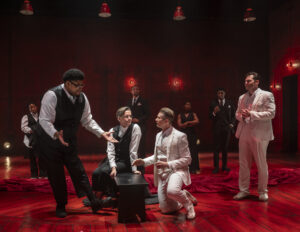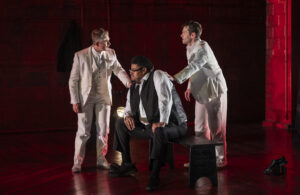
 **** Tom Stoppard’s “Rosencrantz and Guildenstern Are Dead” is a humorous yet dead serious take on two minor characters from Shakespeare’s “Hamlet.” While the two were often mistaken for each other throughout Shakespeare’s original play, Stoppard’s takeoff posits that Rosencrantz (Nate Burger) and Guildenstern (Erik Hellman) constantly mistake themselves for each other. Their jovial banter and constant intrusion on the physical and psychological boundaries between them resemble that of Estragon and Vladimir in Samuel Beckett’s “Waiting for Godot.” This means that their existence might be on some plane between life on this planet and life in another dimension or somewhere between life and death—or none of the above. The story begs the question: What does existence and non-existence really mean? But Stoppard throws one more monkey wrench into his script. Based in good measure on the roles that the characters must play in helping or hindering Hamlet, the two men seem to exist only because they were once summoned by him. To put this another way, if the characters of Rosencrantz and Guildenstern had not been summoned by Hamlet (and defined by Shakespeare before that), could they have ever existed in the first place?
**** Tom Stoppard’s “Rosencrantz and Guildenstern Are Dead” is a humorous yet dead serious take on two minor characters from Shakespeare’s “Hamlet.” While the two were often mistaken for each other throughout Shakespeare’s original play, Stoppard’s takeoff posits that Rosencrantz (Nate Burger) and Guildenstern (Erik Hellman) constantly mistake themselves for each other. Their jovial banter and constant intrusion on the physical and psychological boundaries between them resemble that of Estragon and Vladimir in Samuel Beckett’s “Waiting for Godot.” This means that their existence might be on some plane between life on this planet and life in another dimension or somewhere between life and death—or none of the above. The story begs the question: What does existence and non-existence really mean? But Stoppard throws one more monkey wrench into his script. Based in good measure on the roles that the characters must play in helping or hindering Hamlet, the two men seem to exist only because they were once summoned by him. To put this another way, if the characters of Rosencrantz and Guildenstern had not been summoned by Hamlet (and defined by Shakespeare before that), could they have ever existed in the first place?
While the message of “Rosencrantz and Guildenstern” largely has to do with the existentialism inherent in the human condition, the play is just as much about the journey of an actor’s life (and death) in the theatre. This is the message that The Player (Lorenzo Rush Jr.) reminds us on more than one occasion. He is the guardian of the theatre as well as the ruler of absurdity. What can be more absurd than having life and death portrayed on stage before an audience, especially when none of us truly have a clue what it is all about? Tied into this notion is the juxtaposition of what life in the theatre means from the point of view of the characters who are being performed. Instead of waiting for Godot, Rosencrantz (Estragon) and Guildenstern (Vladimir) wait to be resurrected in their next theatrical performance. Are they “dead” in between performances? Furthermore, it becomes clear that characters can live or die on stage, which does not necessarily coincide with the real life and death of the actors who play them.
In conjunction with the famous Shakespearean trope of “a play within a play” are Stoppard’s figurative concentric circles. These are perhaps best indicated by the red scarves that have been tied together and mark out illusory boundaries on the floor. The set is painted 99% in red, which includes the entire floor and walls, because as The Player maintains, “The audience wants to see blood.” Small props such as black benches are creatively arranged and rearranged on stage throughout the performance. Various curtains (mostly in slate and white) are used to emphasize the unreality of space and time. My favorite is towards the end when The Player makes it clear that death can never be escaped and uses the black curtain to usher out characters. Curtains are always moving… and the directing by Charles Newell goes in lots of different and unconventional directions, especially when it comes to bringing out body language. For example, my guest was practically creeped out when Hellman appeared supine on the stage with his head tilted back towards the audience—with his eyes looking directly into ours in the second row. The eeriness of it is something my guest said he’ll never forget.
The costumes for Rosencrantz and Guildenstern are contemporary, and for most of the show, they wear almost identical white suits. Rosencrantz is somewhat less fussy and wears his white suit with no tie, whereas Guildenstern is neater and wears a tie and a white vest in addition. The only real exception occurs when the two wear dark blue-green shrouds on occasion. The rest of the cast is dressed entirely in black and white and in various styles and manner of costume; and of course, The Player must wear his cape. Other “Hamlet” players include Rob Lindley (Polonius/Ensemble), Charence Higgins (Ophelia/Ensemble), Blake Hamilton Currie (Hamlet/Ensemble), Amir Abdullah (Claudius/Ensemble), and Elizabeth Ledo (Gertrude/Ensemble). Scenic design by John Culbert, costume design by Raquel Adorno, lighting design by Keith Parham, sound design by Andre Pluess, and wig and hair design by Rueben D. Echoles all meld together perfectly in a way that would seem improbable in a universe that is not based on synchronicity and coincidence.
In fact, we start out with Rosencrantz and Guildenstern talking about probabilities. Doesn’t our uniqueness violate the laws of probability? How can a probabilistic world be so improbable? And by extension, this play is improbable. But that’s a good thing. Between the comic wordplay and the contests between the two men and way they interact with the real and imagined Hamlet as well as with the cast of the characters from the play “Hamlet”, Stoppard’s absurdist mélange becomes all the more absurd. Then there is confounding of place and lack of place. When the fourth wall is broken, the question must be asked: What is the audience doing here? So who are we in the audience, as individuals and as a serendipitous group of people who all showed up on a given evening? What are we doing here, and why? And above all, where is East? But we learn in this show that life has no orientation. It simply has to be lived.
Newell has done a top-notch job not just with directing this show and many others, but he can also boast of a thirty-year tenure as artistic director of the Court Theatre. In this final project of his career, today’s production seems almost like an inside joke. Shakespeare’s original venue in London was indeed the Court Theatre, and throughout portions of the play, we see the name “Court Theatre” prominently painted on the cinderblock back wall of the stage. But just because it is written, that doesn’t mean that the setting is any more or less real. It doesn’t make the stage any more Chicago than London. Rather, the actual stage is far removed from both. It lies in our collective imagination.
When life is a stage, its characters are in the mind of God; whereas on stage, they are in the mind of the playwright. From their own limited perspective of being characters (rather than flesh and blood individuals), they don’t know who is writing (or has written) the script. However, it is the director who ultimately decides what the audience sees and hears and determines the style and type of action that the actors should produce. Thus, it is the distance between the playwright’s and the director’s visions that leads to various interpretations of the script. Basically, it is the director’s job to take the written word and interpret it in such a way so as to recreate and reinvent stories—and turn a fictional tale into a plausible reality—or not! Just as Rosencrantz and Guildenstern were once summoned up by Hamlet (and, of course, by the mind of Shakespeare), today’s Court Theatre has been summoned up as a sign and symbol of the value of the creative arts, with the artistic director having the insight to get us to think in novel ways. What a sublime coincidence it has been to have such a talented and visionary individual as Newell engage audiences since the mid-1990s. What are the odds of that?
“Rosencrantz and Guildenstern Are Dead” is playing through April 28, 2024, at Court Theatre, 5535 S. Ellis Avenue, in Chicago’s Hyde Park neighborhood, on The University of Chicago campus.
 Tickets are: $21.50-$91.50 plus applicable transaction and delivery fees.
Tickets are: $21.50-$91.50 plus applicable transaction and delivery fees.
Performance schedule:
Wednesdays, Thursdays, and Fridays – 7:30 p.m.
Saturdays and Sundays – 2:00 p.m. and 7:30 p.m.
For more information and to purchase tickets, go to: https://tickets.courttheatre.org/Online/default.asp or call the box office at 773-753-4472.
For general information about Court Theatre and to learn about their other offerings, visit https://www.courttheatre.org/ or call the box office at 773-753-4472.
If you have any accessibility needs, please contact the box office at 773-753-4472 so they can best assist you.
To see what others are saying, visit www.theatreinchicago.com, go to Review Round-Up and click at “Roencrantz and Guildenstern Are Dead”.






More Stories
“The Magic School Bus: Lost in the Solar System”
“February House” reviewed by Julia W. Rath
” A Lie of The Mind”